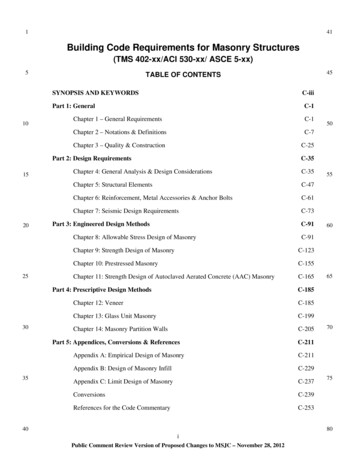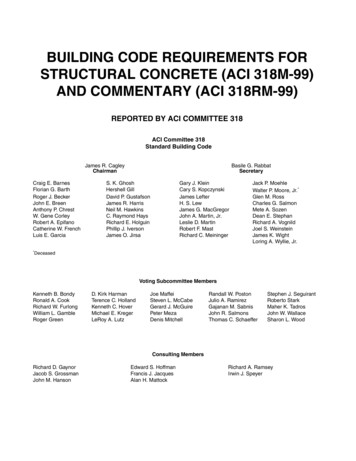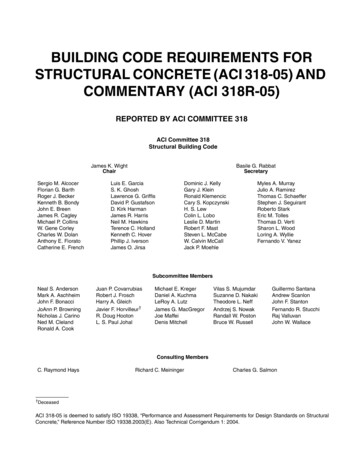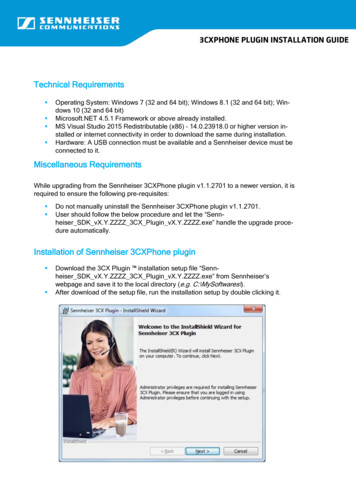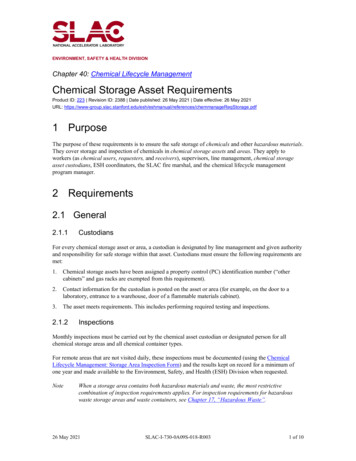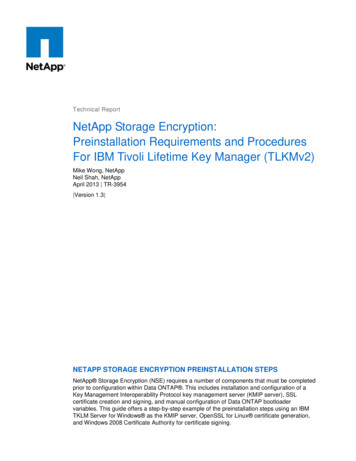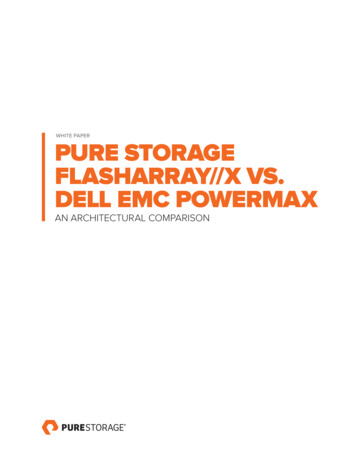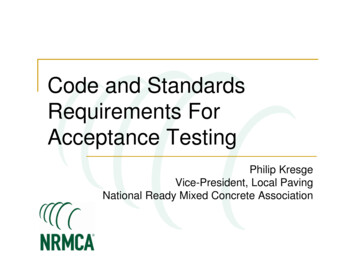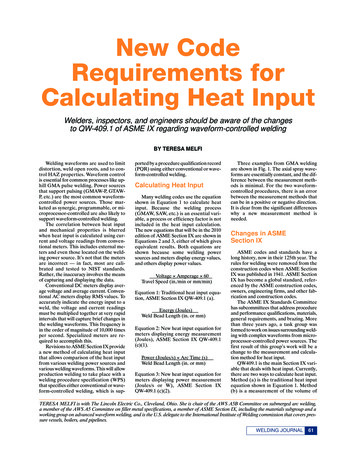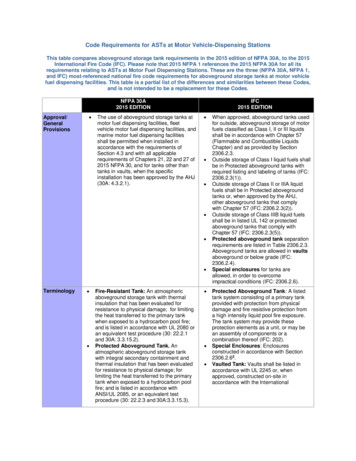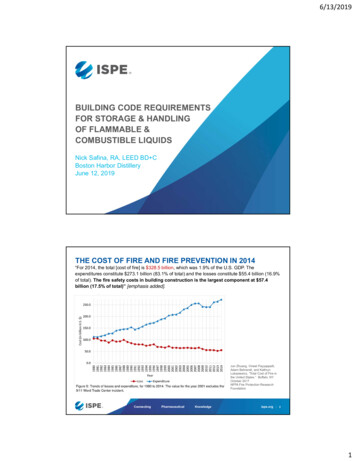
Transcription
6/13/2019BUILDING CODE REQUIREMENTSFOR STORAGE & HANDLINGOF FLAMMABLE &COMBUSTIBLE LIQUIDSNick Safina, RA, LEED BD CBoston Harbor DistilleryJune 12, 2019THE COST OF FIRE AND FIRE PREVENTION IN 2014“For 2014, the total [cost of fire] is 328.5 billion, which was 1.9% of the U.S. GDP. Theexpenditures constitute 273.1 billion (83.1% of total) and the losses constitute 55.4 billion (16.9%of total). The fire safety costs in building construction is the largest component at 57.4billion (17.5% of total)” [emphasis added].Jun Zhuang, Vineet Payyappalli,Adam Behrendt, and KathrynLukasiewicz, “Total Cost of Fire inthe United States.” Buffalo, NYOctober 2017NFPA Fire Protection eispe.org21
6/13/2019APPLICABLE CODES 780 CMR, 9th EDITION - MASSACHUSETTS BUILDING CODE(2015 International Building Code with Mass. Amendments) 527 CMR - MASSACHUSETTS COMPREHENSIVE FIRE CODE(NFPA 1-2015 Adopted by Reference with Amendments) (Portions of the) 2015 INTERNATIONAL FIRE CODE NFPA 30 – FLAMMABLE AND COMBUSTIBLE LIQUIDS CODE NFPA 45 – FIRE PROTECTION FOR LABORATORIES USINGCHEMICALS NFPA 704 – IDENTIFICATION OF THE HAZARDS OFMATERIALS FOR EMERGENCY RESPONSE MGL Title XX “Public Safety”, Chapter 148 is Fire PreventionSection 9 and Section 13 Deal with flammables LOCAL CODES – DON’T FORGET THE LOCAL 0 CMR - MA Amendments to the IBC101.4.5 Fire Prevention. Reference to sections of the International Fire Code (IFC) for fireprevention requirements shall be considered reference to 527 CMR: Board of Fire PreventionRegulations. Reference to sections of the International Fire Code (“IFC”) for building coderequirements are adopted, except that retroactive requirements of the IFC are not adopted.102.4 Referenced Codes and Standards. The codes and standards referenced in 780 CMR shallbe considered part of the requirements of 780 CMR to the prescribed extent of each suchreference. Where differences occur between provisions of 780 CMR and referenced codes andstandards, 780 CMR shall apply.Section 427 Bulk Merchandising Retail Buildings427.11 Flammable/Combustible Liquids. The display, storage, protection, and maximumallowable quantities of flammable and combustible liquids permitted in mercantile display areasshall be in accordance with NFPA 30.ConnectingPharmaceuticalKnowledgeispe.org42
6/13/2019527 CMR - MA Amendments to NFPA 1-20151.04 Adoption by Reference - NFPA 1- 2015 edition as modified by 527 CMR 1.05.1.05 Modifications to NFPA 1- 2015 Edition - on a Chapter by Chapter basis 1.3.3 Conflicts.1.3.3.1 When a requirement differs between this Code and a referenced document, the requirement of thisCode shall apply.1.3.3.2 When a conflict between a general requirement and a specific requirement occurs, the specificrequirement shall apply.1.3.3.3 When the requirements of this Code conflict with any other applicable regulation, or ordinance, theprovisions which establish the higher standard for the promotion and protection of safety and welfare shallprevail.Chapter 66 Flammable and Combustible Liquids66.1.1 The storage, handling, and use of flammable and combustible liquids, including waste liquids shallcomply with this chapter; NFPA 30, Flammable and Combustible Liquids Code; Sections 60.1 through 60.4of this Code; and NFPA 35 Standards for the Manufacture of Organic Coatings, as applicable.66.1.4 Installations made in accordance with the applicable requirements shall be deemed to be incompliance with this Code except that the maximum allowable quantities hazardous materials arelimited to the quantities listed in the Building Code and Table 60.4.2.1.1.3 of this Code: (Table 60.4.2.1.1.3aligns with the MAQs in TEGIES FOR DEALING WITH HAZARDOUS MATERIALSIdentify the Hazards Types of Hazards. IBC deals with two types: Physical and Health Classification of flammable and combustible materials Differentiate between USE / STORAGE, OPEN / CLOSED systems Temperature and pressureInstitute Preventative Measures. Limit quantities, Develop Process Flow plans for material movement EH&S Audits Store in approved containers and storage cabinets Detection (e.g. LEL detectors) and Ventilation (remove vapors) Electrically Classified Spaces (e.g. explosion proof electrical devices)Design Buildings to Minimize the Effects of the hazard if it occurs. Fire proof construction; fire separation barriers; compartmentalization Separation distances – between hazards or buildings Automatic Sprinkler systems; wet, dry, foam Spill containment; Explosion venting Fire department accessConnectingPharmaceuticalKnowledgeispe.org63
6/13/2019IDENTIFY THE HAZARDFLAMMABLE AND COMBUSTIBLE LIQUIDS DEFINEDFlammable Liquid - A liquid having a closed cup flash point below 100 F (37.8 C). Flammableliquids are further categorized into a group known as Class I liquids. The Class I category issubdivided as follows. Class IA - Liquids having a flash point below 73 F (22.8 C) and a boiling point below 100 F(37.8 C). Class IB - Liquids having a flash point below 73 F (23 C) and a boiling point at or above 100 F(37.8 C). Class IC - Liquids having a flash point at or above 73 F (23 C) and below 100 F (37.8 C)Combustible Liquid - A liquid having a closed cup flash point at or above 100 F (38 C).Combustible liquids shall be subdivided as follows. Class II - Liquids having a closed cup flash point at or above 100 F (37.8 C) and below 140 F(60 C). Class IIIA - Liquids having a closed cup flash point at or above 140 F (60 C) and below 200 F(93 C). Class IIIB - Liquids having a closed cup flash point at or above 200 F (93 IFY THE HAZARDHAZARD IDENTIFICATION – NFPA 704Flammability Hazards4. Materials that rapidly or completely vaporize at atmosphericpressure and normal ambient temperature or that are readilydispersed in air and burn readily. Class 1A.3. Liquids and solids that can be ignited under almost all ambienttemperature conditions. Materials is this degree produce hazardousatmospheres with air under almost all ambient temperatures or,though unaffected by ambient temperatures, are readily ignitedunder almost all conditions. Class 1B and 1C.2. Materials that must be moderately heated or exposed to relativelyhigh ambient temperatures before ignition can occur. Materials inthis degree would not under normal conditions form hazardousatmospheres with air, but under moderate heating could releasevapor in sufficient quantities to produce hazardous atmosphereswith air. Class II and IIIA.1. Materials that must be preheated before ignition can occur.Materials in this degree require considerable preheating, under allambient temperature conditions, before ignition and combustion canoccur. Class IIIB.ConnectingPharmaceuticalKnowledgeispe.org84
6/13/2019IDENTIFY THE HAZARDCOMMONLY USED FLAMMABLE AND COMBUSTIBLE LIQUIDSGlacial Acetic Acid IIHexane .IBIsopropanol IBMethanol IBMethyl Ethyl Keytone .IBPentane .IAPropyl Alcohol .ICPyridine .IBTetrahydrofuran Anhydrous .IBToluene .IBTriethylamine IBAcetone, NF .IBAcetaldehyde .IAAcetonitrile IBAcrylonitrile IBBenzene IBtert-Butyl Alcohol .IBCyclohexene .IBDithiothreitol .IIIBEthylacetate .IBEthyl Ether .IAConnectingPharmaceuticalKnowledgeispe.org9MAQ – MAXIMUM ALLOWABLE QUANTITIES Code Prescribed limits for each type of hazard within a Control Area– Staying within the MAQs keeps the building in “ordinary” Use Groups – i.e. (A)Assembly, (B) Business, (F) Manufacturing, or (S) Storage.– Exceeding the MAQ of any hazardous material causes the building or portion of thebuilding to be classified as a High Hazard Use Group. High Hazard Use Groups have building implications and stricter requirements for:– Reduced Building Area and Height– Shorter Egress Distances– Building Layout – location of hazardous material storage and use– Building Construction – Fire Rating of building components– Fire Protection– Spill Containment– Ventilation– Explosion Prevention and/or 5
6/13/2019MAQ – IBC 2015 TABLE Q – IBC 2015 TABLE 307.1 - FOOTNOTES (partial list)a. For use of control areas, see Section 414.2.b. The aggregate quantity in use and storage shall not exceed the quantity listed for storage.c. The quantities of alcoholic beverages in retail and wholesale sales occupancies shall not be limitedprovided the liquids are packaged in individual containers not exceeding 1.3 gallons. In retail andwholesale sales occupancies, the quantities of medicines, foodstuffs, consumer products, and cosmetics,containing not more than 50 percent by volume of water-miscible liquids and with the remainder of thesolutions not being flammable, shall not be limited, provided that such materials are packaged inindividual containers not exceeding 1.3 gallons.d. Maximum allowable quantities shall be increased 100 percent in buildings equipped throughout with anautomatic sprinkler system in accordance with Section 903.3.1.1. Where Note e also applies, the increasefor both notes shall be applied accumulatively.e. Maximum allowable quantities shall be increased 100 percent when stored in approved storage cabinets,day boxes, gas cabinets, gas rooms or exhausted enclosures or in listed safety cans in accordance withSection 5003.9.10 of the International Fire Code. Where Note d also applies, the increase for both notesshall be applied accumulatively.f.Quantities shall not be limited in a building equipped throughout with an automatic sprinkler system inaccordance with Section 903.3.1.1g. Allowed only in buildings equipped throughout with an automatic sprinkler system in accordance withSection 903.3.1.1h. Containing not more than the maximum allowable quantity per control area of Class IA, IB, or ICflammable e.org126
6/13/2019MAQ – IBC 2015 TABLE 307.1 – FOOTNOTESMaximum Quantities in Control Areas100%400%200%Control Area with noadditional provisionControl Area withsprinklersUse Footnote ‘a’Use Footnote ‘a’ ’d’Control Area withflammables storagecabinetUse Footnote ‘a’ ’e’Control Area withflammables storagecabinet and sprinklersUse Footnote ‘a’ ’d’ ’e’orConnecting PharmaceuticalKnowledgeispe.org13CONTROL AREASIBC Section 202 Definitions - Control Areas - Spaces within a building where quantities ofhazardous materials not exceeding the maximum allowable quantities per control area are stored,dispensed, used or handledLVL 10 LVL 7-9LVL 4-6LVL 3LVL 2LVL 1Assumes Class IB Flammable 7
6/13/2019CONTROL AREASGraphic of ratings and reduction in permitted chemical e15CONTROL AREASExample - Combined Limit of Class 1A, 1B & 1C Flammable LiquidsLevel 4Level 3Level 2Level 1Lower Level(Level below grade)60 Gallons60 Gallons(up to 30 in use)(up to 30 in use)240 Gallons240 Gallons(up to 120 in use)(up to 120 in use)IndividualControl Area360 Gallons360 Gallons360 Gallons(up to 180 in use)(up to 180 in use)(up to 180 in use)480 gallons480 gallons480 gallons480 gallons(up to 240 in use)(up to 240 in use)(up to 240 in use)(up to 240 in use)360 Gallons360 Gallons360 Gallons(up to 180 in use)(up to 180 in use)(up to 180 in use)ConnectingPharmaceuticalKnowledgeIn-Use: Any open bottlesconnected to a runningexperiment / equipment;chemicals within secondarycontainers for immediateuse; cleaning squirt bottles;waste cans.Stored: Any closed original orsecondary containers forlater use located withinflammable liquid storagecabinet.Class 1A liquids: haveadditional limits within theseamounts.*Flammables/Combustiblesshown for samplepurposes. All IBC/ IFCChemicals to be tracked& controlledispe.org168
6/13/2019WHAT HAPPENS IF THE MAQs ARE 17HIGH HAZARD OCCUPANCIESIBC 2015 Section 307High-Hazard Group H - High hazard Group H occupancy includes, among others, the useof a building or structure, or portion thereof, that involves the manufacturing, processing,generation or storage of materials that constitute a physical or health hazard in quantitiesin excess of those allowed in control areas complying with Section 414, based on themaximum allowable quantity limits for control areas set forth in Tables 307.1(1) and307.1(2). Hazardous occupancies are classified in Groups H-1, H-2, H-3, H-4 and H-5.Group H occupancies are required to be separated from other Use Groups by Fire Barriersor Fire WallsFire Barrier. A fire-resistance-rated wall assembly of materials designed to restrict thespread of fire in which continuity is maintained.Fire Wall. A fire-resistance-rated wall having protected openings, which restricts the spreadof fire and extends continuously from the foundation to or through the roof, with sufficientstructural stability under fire conditions to allow collapse of construction on either sidewithout collapse of the wall.ConnectingPharmaceuticalKnowledgeispe.org189
6/13/2019HIGH HAZARD OCCUPANCIESIBC 2015 Section 307High-hazard Group H-1. Buildings and structures containing materials that pose a detonationhazard shall be classified as Group H-1.Such materials shall include, but not be limited to, thefollowing:oDetonable pyrophoric materialsoExplosivesHigh-hazard Group H-2. Buildings and structures containing materials that pose adeflagration hazard or a hazard from accelerated burning shall be classified as Group H-2.oClass I,II or IIIA flammable or combustible liquids which are used or stored innormally open containers or systems, or in closed containers or systemspressurized at more than 15psi gage.High-hazard Group H-3. Buildings and structures
12.06.2019 · FOR STORAGE & HANDLING OF FLAMMABLE & COMBUSTIBLE LIQUIDS Nick Safina, RA, LEEDBD C Boston Harbor Distillery June 12, 2019 Connecting Pharmaceutical Knowledge ispe.org THE COST OF FIRE AND FIRE PREVENTION IN 2014 2 Jun Zhuang, Vineet Payyappalli, Adam Behrendt, and Kathryn Lukasiewicz, “Total Cost of Fire in the United States.” Buffalo, NY October
